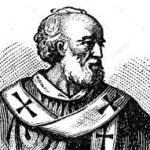
Pope Boniface II was the 55th pope and served for just over two years before his death. Most know him as the first Germanic man chosen for the role.
Pope Boniface II served a notably brief tenure of just over two years before his passing. His papacy, marked by its short duration, was nonetheless a period of significant ecclesiastical intrigue and conflict.
Boniface II’s election was immediately contentious, as it followed a divisive papal selection process that saw him pitted against an antipope, Dioscorus. Though Dioscorus’s early death dissolved the immediate dispute, Boniface II’s reign was still characterized by efforts to consolidate his authority and navigate the Church through internal discord.
Notably, his attempts to designate a successor were met with resistance, highlighting the challenges of papal succession in this era. This guide delves into the complexities of Boniface II’s papacy, examining the dynamics of church politics at the time, his contributions to the Church despite the brevity of his leadership, and the lasting impact of his efforts to maintain unity within the Christian community amidst turbulent times.
Becoming Pope
Pope Felix IV worked closely with Boniface II and choose him as his successor. Boniface II was an archdeacon at the time and known for his close relationship with the pope. When Pope Felix IV realized that he was close to death, he convened a team at his bedside and told members of the Catholic clergy that he selected Boniface II as the next pope. Both Boniface II and Dioscorus were chosen as pope and competed against each either directly for the role. Upon his death less than a month later, Boniface was officially chosen as the new pope.
Second Synod
In the hopes of eliminating the issues associated with his papacy, Boniface II called together the second synod and suggested a new constitution. This new rule would give popes the right to select and name their successors before their deaths. Though some approved of the plan, others did not. Within a few years, the Church would cancel the constitution, which led to Boniface II burning his copy of the order.
Council of Orange
One of the largest moments associated with Boniface II is the Council of Orange. Also known as the Second Synod of Orange and the Council of Orange 529, it brought together bishops from the Ostrogothic Kingdom. This would change the interpretation of Augustine and lead to scholars in the future interpreting those words in new ways. Boniface II confirmed the decisions made by that council, including the concept that religious leaders must teach grace to help their parishioners achieve salvation.
Death of Boniface II
Boniface II outlived Dioscurus by nearly two years. He served as pope from September of 530 to October of 532. Historians are unsure of his cause of death but generally believe that he passed away from natural causes. Just a few days after his death, Boniface II was buried in St. Peter’s Basilica.
Quick Facts About Pope Boniface II
- Boniface II was born in Rome, Italy circa 450.
- There are no records to indicate his name at birth.
- He died on October of 532 in Rome.
- Due to his advanced age, historians believe that Boniface II died of natural causes.
- The Church elected him as pope on September 17, 530 and crowned him on September 22 of that same year.
- His papacy ended upon his death in 532.
- John II succeeded him as pope.
Interesting Facts About Pope Boniface II
- Boniface II is one of the only men who served as a pope without being directly elected to the position. It took nearly a month from the time Pope Felix IV chose him for him to officially become pope. After the death of Dioscorus, the men who supported him aligned with Boniface II.
- Though he hoped to name his successor, John II would become the next pope after the Church chose him. Boniface II had no say in his election.
- Boniface II was the pope who changed the design and use of the calendar. He is the reason that people use the AD format today.
- During his papacy, Rome experienced a famine that led to the deaths of thousands of people. Boniface did charitable acts to help others during the famine and encouraged other members of the Church to do the same.
- Visitors to Rome can pay their respects to Boniface II at the basilica where a portion of his epitaph remains.
A list of all the popes named “Boniface”
Boniface I (St.) (#42) (418 – 422)
Boniface II (#55) (530 – 532)
Boniface III (#66) (607)
Boniface IV (St.) (#67) (608 – 615)
Boniface IX (#204) (1389 – 1404)
Boniface V (#69) (619 – 625)
Boniface VI (#113) (896)
Boniface VIII (#194) (1294 – 1303)